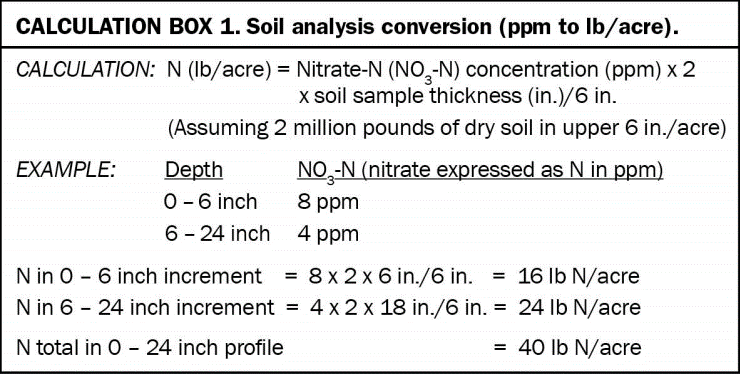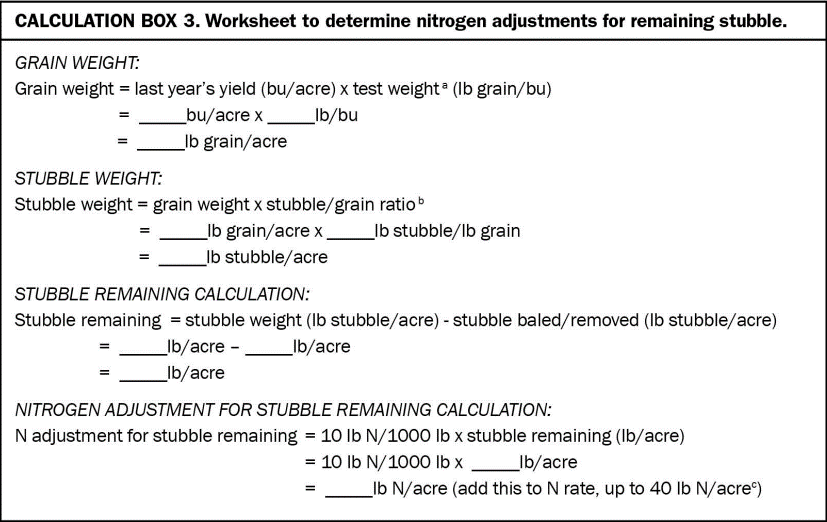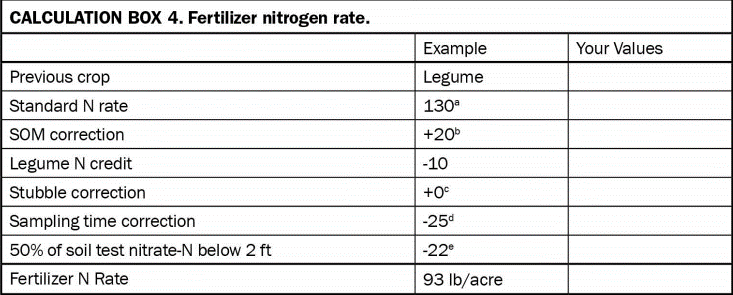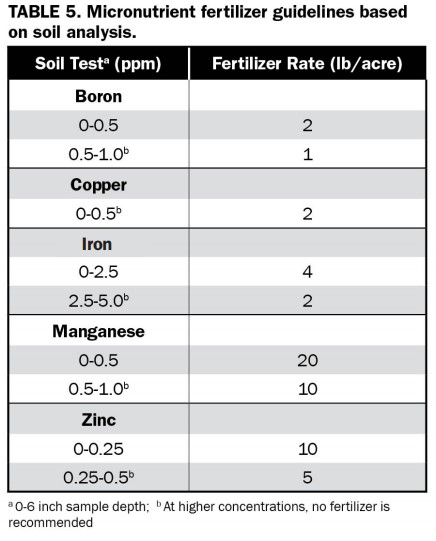
Developing Fertilizer Recommendations for Agriculture
Developing fertilizer rates specific to your soil and crops should improve crop yield and profit.
Last Updated: 07/19by Courtney Pariera Dinkins, former Research Associate; and Clain Jones, Extension Soil Fertility Specialist/Assistant Professor, Department of Land Resources and Environmental Services
THE PURPOSE OF THIS GUIDE IS TO PROVIDE
producers, Extension agents and crop advisers with the tools to more accurately determine fertilizer rates to optimize crop yield and reduce loss of nutrients to the environment.
Fertilizer Recommendations and Guidelines
Soil test results typically include a fertilizer recommendation that is based upon previous crop, the crop to be grown and yield goals (just for nitrogen, N).However, recommended fertilizer rates may be adjusted based on climate and soil properties at your specific location due to the high degree of variability throughout the state of Montana. In addition, many labs do not use Montana guidelines, so you may need to determine fertilizer rates yourself, or at least check the recommended rates. If you are unfamiliar with soil test reports, developing yield goals or fertilizer calculations, please first see the MontGuide Interpretation of Soil Test Reports for Agriculture (MT200702AG). Resources mentioned in this bulletin are listed under “For more information” at the end of this bulletin.
Crop advisers and agricultural Extension agents generally know regional differences in nutrient needs, so if you are a producer, they may be the best source for specific recommendations. However, this guide is designed to help you determine approximate fertilizer rates based on Montana State University guidelines Fertilizer Guidelines for Montana Crops (EB0161). Keep in mind that the guidelines presented here are considered the best averages for the entire state, and may not represent your local soil and climate conditions.
Soil Analysis Conversion
Laboratories report some nutrients in parts per million (ppm), and, generally, will convert results from ppm to pounds per acre (lb/acre) for mobile nutrients, such as N. However, if soil sampling depth was not provided to the lab, this conversion cannot be made. To determine N application rates, results in ppm will need to be converted to lb/acre (see Calculation Box 1).

Fertilizer Recommendations
Nitrogen
Standard Rate
To calculate a standard (or approximate) N fertilizer rate, you only need 1) your soil nitrate-N (nitrate expressed as level, 2) the crop to be seeded, and 3) your yield goal, generally based on recent averages. MSU guidelines are based on the general N requirements to attain a desired yield (i.e. N required per bushel or ton). For example, these guidelines suggest 3.3 pounds of N per bushel (lb N/bu) of spring wheat, 2.6 lb N/bu of winter wheat, 1.2 lb N/bu of malt barley and 25 lb N/ton of grass. After the total available N needed is either calculated, or found in Tables 1-17 of Fertilizer Guidelines for Montana Crops (see Table 1 for an example), the amount of soil available N (from test report) is subtracted from the total available N needed to determine fertilizer N need. The result will be in pounds per acre, also referred to as ‘units of N.' See Calculation Box 2 for an example (on crop-fallow). You can also use the fertilizer calculator provided at www.sarc.montana.edu/php/soiltest/.
TABLE 1. Winter wheat nitrogen guidelines based on soil analysis. Taken from Table 17 in Fertilizer Guidelines for Montana Crops which also lists other crops.
| Yield Potential (bu/ acre)a | Available N (lb/ acre)b |
| 30 | 78 |
| 40 | 104 |
| 50 | 130 |
| 60 | 156 |
| 70 | 182 |
| 80 | 208 |
| 90 | 234 |
a Attainable yield with all growth factors optimized. b Fertilizer N = Available N - soil NO3-N
Adjustments to Standard Rate
To adjust the standard N rate based on your specific conditions, it is useful to know the soil organic matter (SOM) content, the previous crop, the amount of straw residue remaining on the surface in continuously cropped fields, soil sampling date, and sampling depth (if more than 2 feet). Adjustments based on these five factors follow.
1. The level of SOM in your field should relate directly to how much N is released during the growing season. MSU guidelines assume a typical SOM content of 2 percent. If the SOM content is 1 percent or lower, 15 to 20 lb N/acre should be added to your standard rate because less N will likely be released from the SOM present. Conversely, if the SOM is 3 percent or higher, you can subtract 15 to 20 lb N/acre from your standard rate.
2. If the previous crop was a legume, N rates can be decreased because some N will likely be released from the residue of these high N containing crops during the growing season. For example, MSU guidelines suggest decreasing the N rate by 40 lb N/acre if the previous crop was alfalfa. This is termed as an N ‘credit.' The N credit for annual legumes grown for grain ranges from 0 to 20 lb N/acre. It is recommended that a smaller credit (<10 lb N/acre) be used on fields that have only had one year with an annual legume, whereas a larger credit (10-20 lb N/acre) can be used when annual legumes have been grown at least 3 years or grown as a green manure for one year. Biennial or perennial legume green manures contribute about 40 lb N/acre.
3. If fertilizer N will be surface applied to small grain stubble left on the surface from the previous year, some N will generally be tied up (‘immobilized’). Add 10 lb N/acre to your standard N rate for each 1000 lb stubble per acre that remains on the surface, up to 40 lb N/acre. Subtract any amount of stubble removed as baled straw from the stubble weight to determine the amount of stubble remaining. Stubble to grain ratios for barley, spring wheat and winter wheat are approximately 1.13, 1.33 and 1.67 lb stubble/lb grain, respectively. See Calculation Box 3 for N adjustments based on remaining grain stubble.
4. Soil sampling time is important because MSU guidelines assume that sampling occurred in the spring. Soil testing in the fall does not always reflect the true amount of N that will be available at spring seeding because soil nitrate can be gained or lost over winter. Some SOM decomposition occurs during the winter months, releasing plant-available N in a process called “mineralization.” Fall nitrate-N levels will be similar to spring nitrate-N levels if the fall and winter are cold and dry because these conditions decrease N mineralization.
|
CALCULATION BOX 2. Fertilizer nitrogen rate for spring wheat after fallow.
Spring wheat N fertilizer guidelines for a 50 bu/acre yield potential = 165 lb N/acrea Soil NO3-N (from soil test report) = 40 lb N/acre
Fraction of N in urea fertilizer (46–0–0) = 46% = 0.46 lb N/lb urea
CALCULATIONS:
Fallow-spring wheat
Recommended fertilizer N = recommended N – soil NO3-N
= 165 lb/acre – 40 lb/acre = 125 lb/acre
Fertilizer (urea) needed = recommended fertilizer N ÷ fraction of N in fertilizer
= (125 lb N/acre) ÷ (0.46 lb N/lb urea) = 272 lb urea/acre
|

Based on a 3-year, 8-site, Montana study, nitrate levels were 12 to 28 lb N/acre higher in early April than in late August due to N mineralization (Fertilizer Facts No. 55). The smaller increases occurred following fallow and small grains and the higher were found after annual legumes and oilseeds. Therefore, if soil is tested in the late summer or early fall, your fertilizer N rate in the spring of the following year can be decreased by about 15-25 lb N/acre. This adjustment is dependent upon the previous crop, SOM content and fall/ winter weather conditions. In very wet winters, spring nitrate-N levels can be lower than in the fall (Jones et al. 2011) especially in coarse or shallow soils, likely due to leaching. So, fertilizer N rates in very wet winters should be somewhat increased over rates suggested by fall soil samples.
If fall sampling is preferred, a few spring samples are very helpful to compare with fall samples, to estimate future adjustments on fall samples.
5. MSU fertilizer guidelines are based on soil tests from the top 2 feet of soil because the best correlations between N uptake and soil N come from this sampling depth. However, substantial amounts of nitrate-N can be present below 2 feet, especially in crop-fallow systems when yield goals have not been met in recent years. Therefore, some crop advisers sample nitrate-N to deeper depths and the amount of nitrate-N (in lb/acre) in the entire sampled profile (up to 4 feet) can be used to calculate fertilizer N amounts. However, if there are dry layers that would prevent roots from penetrating to this depth, substantial leaching is probable, or if shallow rooted crops are being grown, it is likely that not all of this nitrate-N will be available. In these cases, it is recommended to only assume a fraction of the nitrate-N in these lower depths will be accessed. Although there is no hard and fast rule, a rough guideline would be to use 50 percent of the nitrate-N at depths from 2 to 4 feet in calculating fertilizer N needs. See Calculation Box 4 to adjust N rates for your situation.

Nitrogen rates can be further adjusted for your fields based on yields and quality from previous years. To determine if past yields have been maximized based on protein for spring wheat and winter wheat, see Fertilizer Facts No. 11 and 26, respectively.
Phosphorus and Potassium
Unlike N, phosphorus (P) is highly immobile and potassium (K) is somewhat immobile in Montana soils, making them less plant available. Due to mobility differences between N, P and K, P and K fertilizer requirements are not based on yield goals and soluble nutrient levels, but instead are based on separate soil tests designed to estimate plant availability.
There are three basic approaches to fertilizing plants with P and K: sufficiency, maintenance and build. The sufficiency approach recommends applying the minimum amount of fertilizer necessary to maximize yield in the current year. The maintenance approach recommends replacing the nutrients removed at harvest, and is generally used when soil test levels are high (above ‘critical levels’). Critical levels are nutrient levels above which it often does not pay to fertilize. The build approach recommends applying fertilizer to increase nutrient availability over time and save on fertilizer in future years, and is generally only used on low Olsen P soils.
To use the sufficiency approach, use Tables 2 and 3 for P and K, respectively. If using the sufficiency approach, and P is broadcast rather than banded, it is recommended that rates be doubled for soils with Olsen P levels between 8 and 12 ppm and tripled for soils with Olsen P levels less than 8 ppm. To use the maintenance approach, use Table 4. To use the build approach, add the values from the sufficiency and maintenance approaches. For examples of sufficiency, maintenance and build fertilization strategies, refer to Calculation Box 5.
If a sufficiency approach is used, and P or K soil test levels are above ‘critical levels,' it is still recommended to use a small amount of starter fertilizer with or near the seed (~10-20 lb nutrient/acre). Starter fertilizer, sometimes called 'pop-up' fertilizer, is often useful in Montana because it can help overcome slow movement of available P and K in cool soils, common at seeding time. See Calculation Box 6 for calculating P fertilizer needs. Note that the amount of P and K in fertilizer is always expressed as P2O5 and K2O.




Sulfur
Unfortunately, responses to sulfur (S) fertilizer are much less consistent than for P and K, partly because concentrations of available S below typical sampling depths can be very high due to high levels of gypsum (calcium sulfate). In addition, soil tests for S often do not accurately reflect S availability. Due to these inconsistencies, MSU fertilizer guidelines do not contain S guidelines.
The highest likelihood of an S response occurs on coarse, shallow soils as these soils generally do not contain much gypsum and have trouble retaining the S that is present. The best way to determine if your field needs S is to apply soluble S fertilizer in strips and measure the response in yield and/or grain protein. If S is needed, an application of 15 to 20 lb of S/acre is recommended the next year, particularly for canola.

Micronutrients
Mineral micronutrients are naturally present in soil, yet are required by plants in lower quantities than macronutrients. They include boron (B), chloride (Cl), copper (Cu), iron (Fe), manganese (Mn), molybdenum (Mo), nickel (Ni) and zinc (Zn). In general, Mo and Ni are present in Montana soils in quantities well above the necessary levels and will not be discussed further. Because micronutrient deficiencies are uncommon, there has been little work in Montana to determine crop-specific micronutrient requirements. Therefore, Montana’s micronutrient fertilizer guidelines (for B, Cu, Fe, Mn and Zn) are independent of crop (Table 5). Banding or foliar applications of metal micronutrients (Cu, Fe, Mn, Zn) is recommended over broadcast applications, because metals are very immobile in soil.
The only micronutrient with confirmed deficiencies in Montana that does not have a critical level, or a fertilizer guideline, is Cl, because not enough research has been conducted on this nutrient. Chloride deficiencies occur in Montana due to both low concentrations of Cl in rainwater and infrequent or low potash (KCl; 0-0-60) use in some areas due to generally high K levels. Deficiencies of Cl have only been documented in wheat. Results from 32 field studies done throughout Montana suggest a yield response to Cl is likely if soil tests below 30 lb Cl/acre in the top 2 feet or plant Cl levels in wheat at the boot stage are less than 0.10 percent Cl (Engel et al. 1998). Chloride can reduce leaf spot damage. Durum wheat grown in fields with 7 lb Cl/acre in the upper 3 feet had 87 percent flag leaf spot damage. In contrast, fields that received 40 lb Cl/acre (as KCl) only had 6 percent leaf spot damage and a 22 percent yield increase (Engel et al. 2001).
If you are applying more than 50 lb/acre of KCl to meet K needs, you will be applying at least 20 lb Cl/ acre, which should generally meet your crop’s Cl needs. A rescue treatment for chloride deficiency is approximately 5 lb Cl/acre as liquid or granular KCl. Surface broadcast KCl is ideally incorporated with irrigation or rain after application. A large percentage of in-season applied Cl may be available to subsequent crops, especially under dryland conditions, because little is removed by the crop and leaching is generally infrequent.

Determination of Fertilizer Cost
Because fertilizers do not contain 100 percent of any one nutrient, caution must be used in calculating fertilizer costs per ton or per acre. Make certain to consider grade in making these calculations. See Calculation Box 7 for an example showing how to calculate cost per lb of N and cost per acre for urea.
Conclusion
By using this guide, accurate fertilizer application rates based on your soil test report can be made. This allows you to check a laboratory’s recommendations or develop your own, especially if using a laboratory that does not use MSU fertilizer guidelines. If you still have questions regarding how much fertilizer to apply based upon your soil test report, please contact your local Extension agent or crop adviser.
References
Engel, R.E., P.L. Bruckner, and J. Eckhoff. 1998. Critical tissue concentration and chloride requirements for wheat. Soil Science Society of America Journal. 62:401-405.
Engel, R, L.J. Bruebaker, and T.J. Ornberg. 2001. A chloride deficient leaf spot of WB881 Durum. Soil Science Society of America Journal. 65:1448-1454.
Jones, C., C. Chen, K. McVay, B. Stougaard, M. Westcott, J. Eckhoff, A. Lenssen, J. Weeding, and M. Greenwood. 2011. Measured and predicted temporal changes in soil nitrate-N levels from late summer to early spring in Montana. In: Western Nutrient Management Conference Proceedings. Mar 3-4, 2011. Reno, NV. 8:77-82.
Acknowledgements
We would like to extend our utmost appreciation to the following volunteer reviewers of the original version of this document:
Rick Engel, Ph.D., Professor, Montana State University, Bozeman, MT
Mr. Jeff Farkell, Certified Crop Adviser and Senior Agronomist, Centrol Ag Consulting, Brady, MT
Grant Jackson, Ph.D., retired Professor, Montana State University, Western Triangle Agricultural Research Center, Conrad, MT
Virginia Knerr, retired Montana State University Extension Agent, Broadwater County, Townsend, MT
Richard Koenig, Ph.D., Associate Dean of Extension, Washington State University Extension, Pullman, WA
Kent McVay, Ph.D., Extension Cropping Systems Specialist, Montana State University, Southern Agricultural Research Center, Huntley, MT
Mark Peterson, Producer, Havre, MT
Extension Materials
These bulletins, and many others, can be found by title under "Extension Publications" at http://landresources.montana.edu/soilfertility (unless another link is provided) or by contacting MSU Extension Publications at (406) 994-3273 or online at https://store.msuextension.org/.
Fertilizer Facts, available online at http://landresources.montana.edu/fertilizerfacts/:
No. 11. Grain yield and protein response to late-season nitrogen in irrigated spring wheat
No. 26. Fertilizing winter wheat with nitrogen for yield and protein
No. 55. Changes in soil nitrate-N levels from late summer to early spring in Montana
Fertilizer Guidelines for Montana Crops (EB0161)
Interpretation of Soil Test Reports for Agriculture (MT200702AG)

